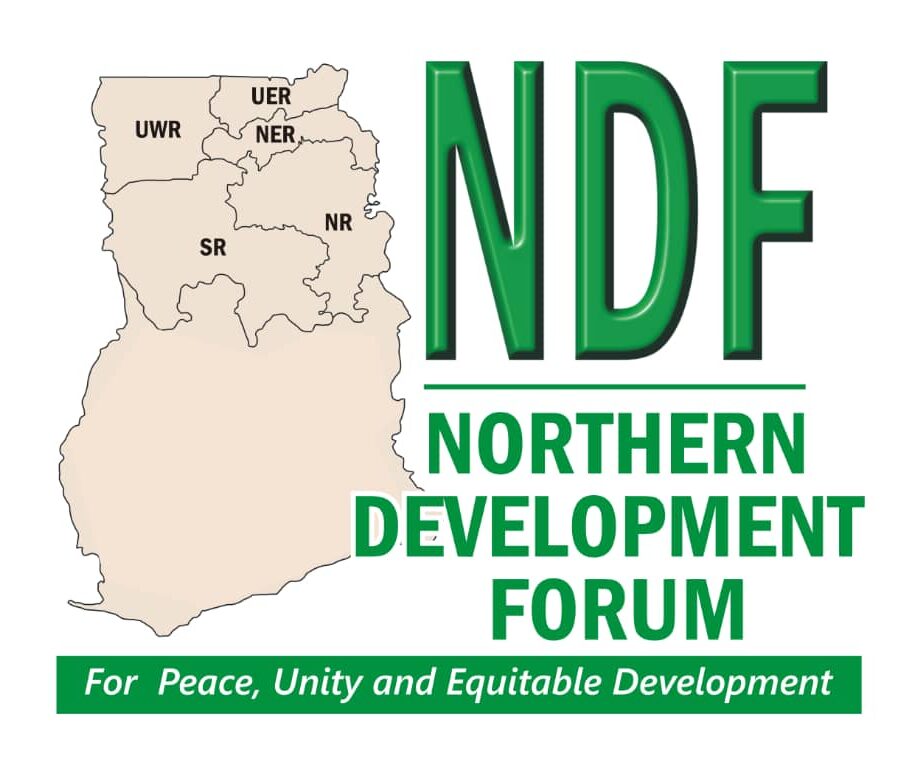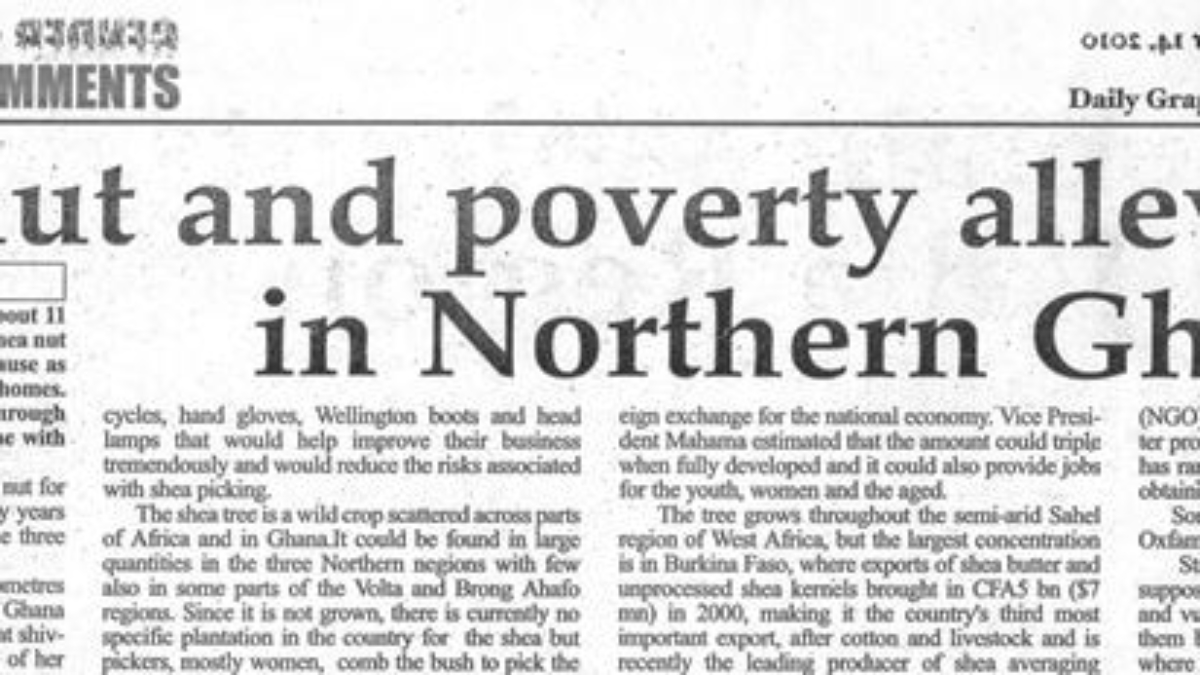DAILY GRAPHIC
THURSDAY, OCTOBER 14, 2010
SHEA NUT AND POVERTY ALLEVIATION IN NORTHERN GHANA
STORY BY: PAUL ACHONGO KWODE
Felecia Kawe (pseudonym) was about 11 years of age when she died through shea nut picking. She did not die a natural cause as is the case in most traditional Ghanaian homes. Kawe died stragely on May 16, 2010 through snake bite in the bush where she had gone with friends at dawn to bring home shea nuts.
Her family of four depended on the shea nut for their daily living since their father died many years ago leaving the blind mother to bring up the three children alone.
Manyoro is a village of about 53 kilometres from Nanvrongo is the Upper East Region of Ghana where she lived. The death of Kawe sent great shivering throughout the village not only because of her death, but rather how the family was going to cope since she was the bread winner of the family.
Their dependence on the shea nut for their daily living occurs mostly at the peak of the shea season during the months of April-August. They did not only depend on it for only their breakfast but lunch and supper.
Her death illustrate a clear case of high risks associated with shea nut picking. Kawe’s tragic death is only one out of many who die during shea picking. Most of the shea nut pickers across the shea producing parts of the country do not have any protective clothing, Wellington boots, hand gloves and this exposes them to harmful creatures and the weather.
The conditions shea nut pickers go through before picking the nuts are too dangerous. The pickers have on countless occasions complained and appealed to the government and civil society and NGO’s to assist them with protective kits.
Some of their complaints include being bitten by snakes because they use their bare hands and sometimes bare feet to comb the bush in search of the nut.
Madam Abdulai Zuwera of the Tungteiya Shea Butter Extraction Women Association of Gushiegu told this writer that “It is out of the nut that we make our daily living and support our children in schools and if the business is left to collapse, where will our future be?”
Madam Zuwera said she would be grateful if members of the association were assisted with tricycles, hand gloves, Wellington boots and head lamps that would help improve their business tremendously and would reduce the risks associated with shea picking.
The shea tree is a wild crop scattered across parts of Africa and in Ghana. It could be found in large quantities in the three Northern regions with few also in some parts of the Volta and Brong Ahafo regions. Since it is not grown, there is currently no specific plantation in the country for the shea but pickers, mostly women, comb the bush to pick the nut. Such a practice results in a large proportion of the nuts being lost.
Shea is often referred to as “Life” especially in Dioula language in Burkina Faso and where it is also generally grown wild, with little need for any speial cultivation or nourishment. There are a few plantations of the crop in Burkina Faso. In Burkina Faso, it is called “women’s gold.”
Almost all parts of the tree have some practical use. The bark is an ingredient in traditional medicines against certain childhood ailments and minor bruises and cuts. The shell of the nuts can repel mosquitoes.
Above all, the fruity part of the nut, when crushed, yields a vegetable oil that could be used in cooking, soap-making and for skin and hair care. Harvesting the nuts and making the butter have traditionally been women’s work. Men usually are involved only in its transportation and marketing.
The cash crop shea is also valuable for the treatment of certain diseases by herbalists. It also offers employment for several individuals who take part in all of its value chain processes. According to the Vice President of Ghana, John Dramani Mahama, more than 900,000 women in the three Northern regions, collect over 130,000 tonnes of dry nuts annually. The industry also benefits close to two million poor people, about 95 per cent of whom are rural households, though its full potential is yet to be exploited. The infant industry is an attractive business venture earning about 30 million dollars of foreign exchange for the national economy, Vice President Mahama estimated that the amount could triple when fully developed and it could also provide jobs for the youth, women and the aged.
The tree grows throughout the semi-arid Sahel region of West Africa, but the largest concentration is in Burkina Faso, where exports of shea butter and unprocessed shea kernels brought in CFA5 bn ($7mn) in 2000, making it the country’s third most important export, after cotton and livestock and is recently the leading producer of shea averaging 50,000Mt while Ghana follows second with production of 45,000MT per annum.
It was therefore heartwarming when Dr. Joshua Yidana, Head of the Horticultural Department of the University for Development Studies (UDS) told this writer that he had been experimenting with the shea tree through grafting propagation.
According to him, the method had proved that the shea tree, through grafting, could bear fruit in a gestation period of between three to six years. He said the research was a breakthrough and if successfully implemented could reduce the gestation period of the crop from 10-15 years to between three to six years and therefore increase production of its products.
The findings are intended to enable farmers and the government to grow the crop just as it is with cocoa.
DR. Yidana said the first ever grafting of the shea nut was successful in 2008 and that he was studying the grafting method at Zoonaaliyi near Nyakpala where about 1,200 grafted plants covering about a hectare of land was being observed. Dr. Yidana’s experiments just like any other academic work have generated heated debates in the academic circles particularly from the Cocoa Research Institute of Ghana (CRIG) which expressed doubt about the findings.
According to them, they had been making several studies on the plant especially on its gestation period but were yet to come to such conclusions.
A lot of Non-Governmental Organization (NGO) have shown interest in promoting shea butter production and marketing in Ghana and support had ranged from linkages to markets, assistance on obtaining technology and training in business skills.
Some of these NGO’s are Send Ghana, SNV, Oxfam, GTZ.
Strangely enough, some of these NGO’s which supposedly aims at protecting the interest of the poor and vulnerable in the shea industry turn to exploit them by setting up some shea processing centres where women pick and process the shea. The poor and vulnerable are usually cheated at the point of purchase as their products are bought cheaply by some of these NGO’s.
Another point of cheating is through the value chain as the companies in the shea industry make huge profits at the expense of the poor.
Some of the NGOs also give loans or credits to these vulnerable farmers in the shea sector with huge interest rates. It is however that the NGOs advocate the best for the shea industry but the interest of the vulnerable farmers must be paramount else they may be using the poor farmers to fight for their own interest. Some of the interventions of some NGOs must however be lauded.
It appears that the shea industry faces numerous challenges which are surmountable. Some other challenges the shea industry is faced with include uncontrolled pricing both locally and internationally, inadequate information of the crop due to limited research, bush burning, loss of shea tree through cutting the trees for charcoal and a host of other problems that needs to be addressed to pave way for more investment with great dividend for the shea industry.
The intervention will not only alleviate poverty through job creation but also contribute to meeting the Millennium Development Goal of reducing poverty as well as enhancing the socio-economic fortune of the country.
There seem to be hope for the shea industry with the ongoing implementation of the Savannah Accelerated Development Authority (SADA).

